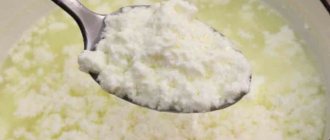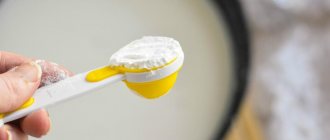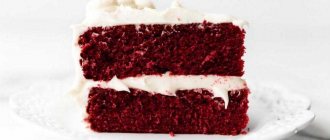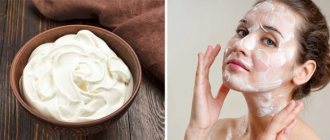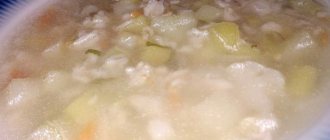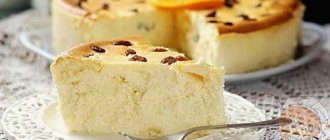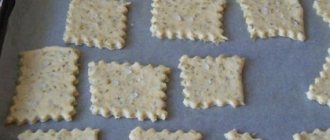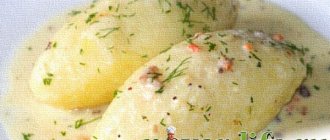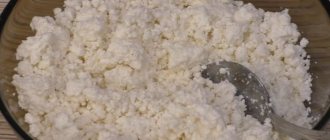COMPOUND
Place on high heat. When the milk warms up, reduce the heat to medium and begin to gently stir the mixture. Bring until it starts to boil.
The milk will curdle and the thick mass will rise to the top. A whitish whey will remain at the bottom.
If you have time, evaporate all the moisture. This will take from 2 to 3.5 hours. To reduce cooking time, drain the cottage cheese in a colander lined with gauze.
Two liters of milk and half a liter of fermented baked milk will yield 500g of cottage cheese. The strained whey can be drunk or used in other dishes. For long-term storage, the whey can be poured into bags and frozen.
Melt the butter in a non-stick frying pan and add the strained cottage cheese. Sprinkle with sugar.
Place the pan on heat just above low. Using a wooden spatula, spread the cottage cheese over the bottom.
4 minutes for the cottage cheese to warm up. After this, the cottage cheese must be stirred constantly. When stirring, you need to lift the cottage cheese from the bottom to the top and at the same time crush the lumps of cottage cheese into small crumbs. When all the moisture from the cottage cheese has evaporated and it becomes reddish in color with whitish specks, remove the cottage cheese from the heat and cool.
Dry cottage cheese, if desired, can be rubbed through a sieve or crushed in a coffee grinder to obtain a finer texture. Exit:
approximately 170 grams.
Source
Cooking red cottage cheese kort
Kort - dried Tatar cottage cheese. On the Internet I also came across such definitions of this cottage cheese as boiled cottage cheese or red cottage cheese. Such cottage cheese is actually prepared by boiling and drying, and also has a reddish tint, or rather brown.)
This product can be eaten as an independent dish. Then honey and butter are added to the court when the court has cooled down. But I have never eaten this cottage cheese this way. I prepare it exclusively for the subsequent preparation of some Tatar pastries, or rather Gubadiya, the recipe for which I am preparing for publication. The court is an integral part of any Gubadiya. But a product like a court is difficult to find in stores, even in Tatarstan.
Apparently that’s why I see real gubadia on sale less and less often. But it is impossible to replace the court with anything in Gubad. This cottage cheese is not like regular cottage cheese in taste and consistency. It has a rich creamy taste or even the taste of baked milk, and even a little caramel.) I love this cottage cheese in baking.
So, when I once decided to bake gubadia, the question arose of where to get the court. And how good it is that I have a wonderful old book “Tatar Cuisine”, in which I found 4 different options for preparing korta. I chose the most convenient and simplest for myself, in my opinion - this is making a court from katyk. But, since I do not live in Tatarstan, I easily replaced katyk with fermented baked milk. These are the same product, different names.
We sell katyki, but they look like kefir. I can say with confidence that this is not a Tatar katyk. I visit Tatarstan often and I know that this is one of our fermented baked milk.)) Moreover, there are both katyk and fermented baked milk on the shelves. Tatar katyk is curdled milk made from baked milk (definition from the book). There is a similar recipe for making kort, but from kefir. I also made it from kefir, but it turns out tastier from fermented baked milk (or katyk).
If we are preparing a court for Gubadiya, then we need to add sugar to taste, sour cream or melted butter to the finished court, mix and heat over the fire. You should get a thick, homogeneous mass, which you can then use for baking.
So let's get started. The process is slow.) We take dishes for cooking with a thick bottom - a saucepan or a frying pan.
Court made of milk and katyk
Recipe for making kort
For this recipe you will need about 5 liters of milk, half a liter of katyk, as well as 1 glass of sugar. Boil the milk and pour katyk into it, stirring constantly. Then continue the boiling process. After a few minutes, you will see how curd begins to form in the bowl. You need to continue boiling until the newly formed curd has a light, reddish tint. After this, add sugar and, stirring again, continue to boil. You need to keep the mixture on the fire until all the liquid has completely boiled away from it. The finished court should be transferred to another container and allowed to cool.
https://youtu.be/oyoCimpxZZc
How to prepare “Kort – dried Tatar cottage cheese” step by step with photos at home
To prepare kort, according to this recipe, we only need fermented baked milk or Tatar katyk. 1 liter is enough to prepare a court for 1 small gubadia (20-21 cm in diameter).
Pour fermented baked milk into a bowl with a thick bottom. This time I took a frying pan to speed up the evaporation process.
Place the frying pan on high heat. Ryazhenka will begin to separate almost immediately. We wait until the liquid (whey) has almost completely evaporated.
When the consistency becomes close to thick semolina porridge, reduce the heat. Then cook with continuous stirring.
This mush will become more and more yellow or even light brown, the moisture will evaporate and the crust will remain in the pan, in the form of such large coarse pieces. Kefir makes the kort even drier, grainy and crumbly. It is important, when there is almost no moisture at all, not to interrupt stirring and keep the heat to a minimum.
Next, according to the recipe from the book, the katyk (ryazhenka) kort needs to be cooled and turned through a meat grinder to obtain a coarser and finer consistency. In fact, after cooling, this court became even a little drier and was very easily crushed using a silicone spatula. In general, you can easily shred the court using a fork. So, the court is ready for further use. I poured the finished court into a glass jar (volume 330 ml, the jar was full) with a lid. And stored in the refrigerator until baking. For gubadia, add sour cream or clarified butter and sugar to taste to the finished kort, mix and heat until it reaches a homogeneous thick consistency. As an independent dish, add butter and honey.
Source
Cottage cheese filling
The second recipe for boiled cottage cheese is more suitable as a filling. For it you will need 1.5 liters of katyk and sour cream or butter, as well as sugar to taste. As for the cooking method, it is very similar to cooking cottage cheese from kefir. True, kort made from katyk, unlike kefir, is not crumbly at all, rather, on the contrary, it is viscous and looks like large pieces. Once ready, cooled to at least room temperature, the court will need to be put through a meat grinder. As a result, you will get an excellent filling.
How to make homemade cottage cheese
In order to get 1 kilogram of dietary cort, you need 1400 grams of low-fat cottage cheese, 1 full glass of sugar and half a liter of milk. Boil the cottage cheese, stirring it with milk until a reddish crust forms. Then add sugar and mix as thoroughly as possible, then let the mixture cool. This kort can be used to prepare gubadiya, or served in plates seasoned with butter.
How to make kurt at home: features and ingredients
Kurt, whose calorie content is 20 kcal per 100 g of product, is a nutritious delicacy. The value lies in the fact that it is rich in proteins - up to 25%. During cooking, they are broken down into amino acids and are well absorbed by the body during eating.
In ancient times, kurt was used by nomads to replenish the body with nutrients and restore lost energy during long treks. The fermented milk product quenched thirst and restored strength.
Appetizing zucchini pancakes: delicious recipe
How is kurt useful for modern people living in big cities? It is famous for its content of microelements, which are important for the functioning of the body, does not contain preservatives and does not lose its beneficial properties during long-term storage. Kurt is indispensable during long hiking trips and walks in the fresh air with children.
To produce kurt, sheep, goat, cow, mare's milk is used, and in the west of Kazakhstan - camel's milk. Cooked in the mountains, dried in the sun, soaked in fresh air, kurt conveys a natural national atmosphere.
But this dish can also be prepared at home. To do this you will need the following ingredients:
Oatmeal with water for weight loss: recipe (with photo)
Milk and yogurt are needed to make cottage cheese. It is the main component of the Kazakh national dish. To save time, take 500 g of ready-made cottage cheese for the dish.
You can use your favorite herbs and garlic along with salt to make the taste brighter and piquant.
Description
Cottage cheese kort is a national Tatar fermented milk product obtained by boiling milk. Thanks to a special cooking technology, this delicacy has a pleasant aroma, as well as an unusual beige color with a red tint (see photo). As for the taste of Tatar kort, it has a caramel note that can surprise even the most demanding sweet tooth.
The advantage of this cottage cheese is that it consists entirely of natural ingredients. It does not contain flavorings, flavor enhancers, and also does not contain food dyes or various preservatives. That is why the product can safely be considered healthy and useful.
How to make kurt from cottage cheese: preparation process
How to make kurt at home? We suggest you try the simplest recipe step by step.
Prepare the base for the kurta like this:
Zucchini with minced meat in the oven: recipe with photos
Homemade cottage cheese is ready to be used in the main dish. The next steps look like this:
As an alternative, drying cabinets or ovens are used, which maintain a temperature of 25°-28° C. This option is equivalent to drying in the sun.
The favorite delicacy of children and adults is popular far beyond the borders of Kazakhstan. Kurt is healthy and filling. And new recipes for preparing the national dish allow you to diversify and improve its taste.
Buckwheat porridge with meat and mushrooms: step-by-step recipe
Be the first to know about everything
Subscribe and learn about the latest news from Kazakhstan, photos, videos and other exclusives.
Source
Benefits and harms
The benefits of the Tatar court are undeniable. Despite the fact that this cottage cheese is subjected to heat treatment, it retains many useful substances, including proteins, fats and carbohydrates. This delicacy is also rich in vitamins and minerals, which makes it deservedly classified as a healthy product.
It has been scientifically proven that the national Tatar cottage cheese is incredibly useful for problems with the digestive system. It is also recommended for use for bone diseases, especially osteoporosis.
Kort, like regular cottage cheese, has a positive effect on the health of teeth, hair and nails. Thanks to its rich vitamin and mineral composition, this product plays an important role in human life. It is especially often recommended to include it in the diet of pregnant women, nursing mothers, as well as children over six months and the elderly.
As for the negative qualities of the court, it is very difficult to talk about them, since this type of cottage cheese is practically not capable of causing harm to human health. It can only be dangerous if you are hypersensitive. However, given that this delicacy contains a lot of protein, in case of atherosclerosis, as well as serious kidney diseases, it is recommended not to overuse this curd dessert.
A real cottage cheese court has excellent properties. It has a divine caramel taste, a pleasant aroma, and a delicate and crumbly texture. It is very difficult to resist such an unusual Tatar delicacy.
Product Photos
Cooking recipes with photos
Sweet Tatar Gubadiya
90 min.
Gubadiya pie with meat
120 min.
Kurt: recipe
There are many products without which it is impossible to imagine Turkic cuisine in general and Central Asian cuisine in particular. In all this variety of meat and dairy delicacies, there is kurt - a unique dish in many ways. It is prepared in Mongolia, Uzbekistan and Kazakhstan. Kurt, the recipe of which has undergone some changes, is present in both Armenian and Georgian cuisines.
In the generally accepted translation, “kurt” is something dried. Probably, previously this was the name given to all workpieces that had undergone similar processing.
Sauerkraut: sugar-free recipe
Nowadays the sun-dried balls are called “kurt”. The small shape of the products is easy to explain. Nomads are accustomed to snacking on the go. So the cheese round is a real ancient energy bar.
Kurt is prepared from a special type of cottage cheese - it is called suzma. We are talking about the fatty mass remaining after the souring of whole milk. Suzma is an independent product. For example, it is put into sorpa and other dishes. It consists of soft cottage cheese and sour cream.
And without ready-made suzma, making a kurt yourself is extremely easy. To do this, take the following:
Baursaki on kefir without yeast: recipe
Fresh curd kurt: Pixabay
Please pay attention to these important points:
Curd kurt: YouTube/Dam Dastarkhany
Industrial cooking method
Considering that red cheese is a popular product, it has recently been produced in many dairies.
Milk is mixed with cream to obtain a liquid mass of 20%. Then it is poured into a digester, heated to 90 °C and fermented with whey at the rate of 10-15% of the total volume of the original mass.
The next stage is to boil the cheese product for at least five hours with constant stirring and gradually adding a certain amount of sugar. To get rid of excess moisture, the product is placed in a thermal pressure chamber and kept until it turns light brown. After this, the red sweet curd undergoes cooling and further packaging.
How to make kurt
The time has come to tell in detail all the secrets of preparing this popular and healthy delicacy throughout Central Asia. Before making kurt at home, you will need to purchase good milk. An important point: take natural farm milk and definitely whole milk. So:
Garlic sauce: recipe with photos and step-by-step description
Preparing milk
The first stage is the most critical. The final result depends on the correctness of its implementation. So:
Pasta with meat: how to cook deliciously
Pasteurization of milk: YouTube / Pavel Gusev
How to make cottage cheese
When the milk has turned sour, start making cottage cheese:
Cottage cheese for kurta: YouTube/Evgenia Panfilova
How to cook kurt
Only when the curd becomes dense and pliable can it be used for kurta. Remove the lump from the towel, and then:
Kurt before drying: YouTube/FARMER KNOWS
It is most convenient to dry the kurt, the recipe for which is given here, in a fruit dehydrator. It can be replaced by an oven turned on at 50 °C (do not close the door). The finished delicacy becomes very hard and relatively light. It can be stored in the dark and dry for at least a year.
How to cook kazy at home?
Be the first to know about everything
Subscribe and learn about the latest news from Kazakhstan, photos, videos and other exclusives.
Source
Medicinal properties
In addition to taste, this cottage cheese has medicinal properties. Modern medicine has established that 100 grams of eremsec contains 20% protein (protein), which is one of the important components for the development of all body tissues.
Red cottage cheese contains a high percentage of calcium, which strengthens bone tissue. In the oral cavity, calcium protects tooth enamel from damage. Dentists have noticed that Eremsek protects against a common dental disease - caries.
In addition to calcium, this cheese product contains the aminocarboxylic acid methionine, which acts as a fat burner and thereby protects the liver from obesity caused by high cholesterol levels. Doctors often advise including eremsec in the daily diet during a course of antibiotic treatment.
Red cottage cheese has a positive effect on the treatment of gastritis, ulcers and other diseases of the gastrointestinal tract.
Gubadia with court - Tatar wedding pie (Gubadia - Tatar Wedding Pie)
Tatar pie with red curd cheese, raisins, rice, eggs
Tatar pie with red curd cheese, raisins, rice, eggs
for test
For filling
for the baby
There is a wonderful gubadia on my table. The famous traditional ritual Tatar pie with red dry cottage cheese - kort.
I always fall in love with food, especially pies. Before cooking, I want to know the history, if there is one, cooking options, and find “carriers”. They use ethnographic and historical articles in native languages, collections of culinary recipes from famous masters of folk cuisine, pleasant acquaintances and friendship.
I was inspired by Marina Dmitrieva from Tatarstan (site “Forks in Hands”), she also discovered for me the book “Tatar Dishes” by Yunus Akhmetzyanovich Akhmetzyanov, published in 1969. The book contains many national Tatar recipes. Yunus Akhmetzyanovich worked for many years at the House of Tatar Culinary Arts in Kazan, represented Russian culinary arts abroad, and served the 1980 Olympics. His approach to cooking was thorough, from studying, collecting and restoring lost recipes from historical sources to developing his own recipes.
Use in cooking
It is noteworthy that in cooking, cottage cheese cord can be used not only as an independent sweet dessert. This delicacy is ideal as a filling for creating other Tatar dishes, for example, for such a famous multi-layer pie as gubadia.
In addition, you can fill other confectionery products with such cottage cheese:
- cheesecakes;
- puff pastries;
- pancakes;
- buns;
- cakes, etc.
However, most often this product is served as a separate delicacy for tea. This is not surprising, because properly prepared kort has truly excellent taste. In addition, it has a very delicate and juicy texture, which makes it pleasantly melt in your mouth.
Gubadia in a wedding ceremony
I have been in love with Gubadia for a long time, ever since the time of preparing the Tatar zur belesh - a large pie with meat and potatoes . These two dishes are indispensable participants in the Tatar wedding ceremony. After nikah, it was customary to treat guests to butter with honey, gubadia, geese and goose belish. In general, in Tatar cuisine there are many dishes with waterfowl, which are a symbol of a huge, prosperous and friendly family, fertility and procreation.
Of course, gubadia - a puff pastry pie with meat or sweet filling - is one of the main ritual dishes. There are several interesting points here. Usually an odd number of layers of filling are formed - how many layers are in the gubadiy, the number of days the groom can stay in the bride’s house. Both the sweet and meat versions always contain dried fruits. According to Tatar legends, raisins, apricots, and prunes are a kind of amulets against everything bad, against the evil eye.
The ritual pie is cut in a special way. Gubadia was cut into four parts, and one of them went to the groom’s house for relatives.
... The groom's father covered the gubadiya with tastymal and put money on top, signaling to the guests that they could taste the treat. The guests came up, left money on a tray for the newlyweds, and took with them a piece of Gubadiya...
Readiness for marriage was judged by baking Gubadiya. A girl should be able to bake a pie so that it is completely baked and the bottom remains dry, especially in the middle. For Gubadiya, the filling should be uniform, the layers should be identical, clear, crumbly, but at the same time juicy due to the huge amount of oil. A piece of gubadia is placed on a plate and eaten with a spoon. I learned how to bake Gubadia - it’s time to get married.
Casserole with sweet cottage cheese. Recipe
You can prepare a casserole for the sweet table using red cottage cheese. Mix a mixture of eremsek (300 grams), two raw eggs, two tablespoons of semolina and a pinch of vanilla powder. Add sugar to taste and bring everything to a homogeneous consistency.
After this, prepare metal molds, first greasing them with refined sunflower oil. Place the curd mixture in them and bake for no more than 20 minutes at a temperature of approximately 200 °C. Then, after cooling completely, remove from the mold and serve to a sweet table with sour cream or berry sauce.
How a store-bought product is made
In industrial production, such concepts as flap or boiled cottage cheese do not occur. The product for mass packaging and sale is obtained in two ways:
- Acid method - fermentation of lactic acid bacteria is added to pasteurized milk. After some time, a clot is obtained. To speed up the process, the milk mass is heated.
- Acid-rennet method - together with lactic acid bacteria, rennet enzyme (as in hard cheeses) and calcium chloride are added to milk to obtain a dense curd and facilitate the expression of whey. The granular product is obtained from rennet by cutting it into small cubes. The resulting “grains” are mixed with sunflower cream.
Beware of dairy products labeled “curd product” or “produced using cottage cheese technology.” Such products have little in common even with milk. In addition, the highest quality industrial product cannot replace a homemade one.
Which cottage cheese is healthier: low-fat or full-fat?
The properties of a low-fat product change: reducing fat in the composition significantly reduces the presence of fat-soluble vitamins:
- A, responsible for vision functions;
- E, which has antioxidant properties;
- D, which helps absorb calcium.
A decrease in the composition of these valuable vitamins leads to a deterioration in the absorption of calcium.
Both low-fat and fatty versions of cottage cheese have their own beneficial features and disadvantages.
The benefits of the former are represented, first of all, by their low calorie content, which is successfully used in dietary nutrition.
Thus, the nutritional value is 60 - 70 kcal more per 100 g for 5 - 9% cottage cheese and 120 kcal more for the 18% version.
Fatty varieties of the product include harmful cholesterol, which contributes to the development of atherosclerosis.
The reduced content of proteins and amino acids reduces the presence of cephalin and lecithin. However, this applies more to fatty cottage cheese, since the amount of protein in the 18% product is slightly reduced: to 15 g, compared to 18 g of low-fat cottage cheese.
In this regard, each type of cottage cheese is valuable, depending on its purpose. However, maximum harm is possible from the consumption and, especially, abuse of fatty fermented milk products.


